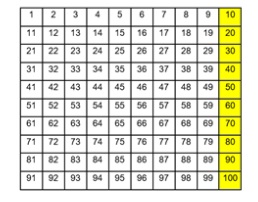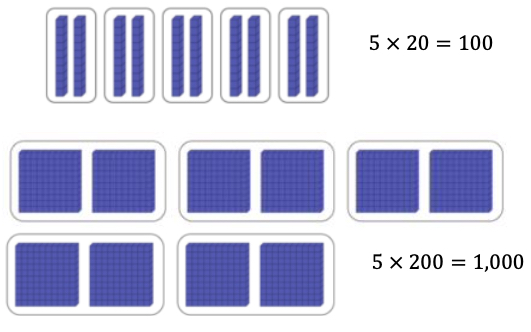Multiply a one-digit whole number by a multiple of 10, up to 90, or a multiple of 100, up to 900, with procedural reliability.
The product of 6 and 70 is 420.
When multiplying one-digit numbers by multiples of 10 or 100, instruction focuses on methods that are based on place value.
| Name |
Description |
| Fishing for Multiples of 10 | This lesson introduces students to multiplying one-digit numbers by multiples of 10. It is a guided inquiry lesson where students will build arrays using base-ten blocks. |
| Tens, Tens, and More Tens | In this lesson, students will practice using various strategies for multiplying one digit numbers by multiples of ten. |
| Rockin' Road Trip MEA | In this model-eliciting activity (MEA), students will work together to determine the best bus for a class trip. Students will be able to decide between several buses with varying capabilities and costs while practicing their application of multiplying one-digit whole numbers by a multiple of ten. Model Eliciting Activities, MEAs, are open-ended, interdisciplinary problem-solving activities that are meant to reveal students’ thinking about the concepts embedded in realistic situations. Click here to learn more about MEAs and how they can transform your classroom. |
| How Long is Your Music Lesson? | In this Model Eliciting Activity, MEA, students will be required to rank musical instrument lesson packages based on the price, the number of minutes of practice each week, and the quality of the instructor.
Part of the task involves students figuring out the elapsed time of the lessons based on their start and stop times. They will also need to figure out the total weekly cost of the lessons based on the number of lessons offered per week and the cost of each lesson based on its length.
The twist will require students to determine whether or not to revise their ranking based on new information about the cost of instrument rentals per lesson and the class size of each package.
Model Eliciting Activities, MEAs, are open-ended, interdisciplinary problem-solving activities that are meant to reveal students’ thinking about the concepts embedded in realistic situations. MEAs resemble engineering problems and encourage students to create solutions in the form of mathematical and scientific models. Students work in teams to apply their knowledge of science and mathematics to solve an open-ended problem, while considering constraints and tradeoffs. Students integrate their ELA skills into MEAs as they are asked to clearly document their thought process. MEAs follow a problem-based, student-centered approach to learning, where students are encouraged to grapple with the problem while the teacher acts as a facilitator. To learn more about MEA’s visit: https://www.cpalms.org/cpalms/mea.aspx |
| Reading is Fun! | In this MEA, students will work in groups to rank books using the following criteria: price, genre, number of pages, reading level and a summary provided for each book. The students must calculate the price for a class set of each book by multiplying each price by 20 students. There is a budget of $100. Students are then given a new budget and a new criteria and asked to re-evaluate their decision. Model Eliciting Activities, MEAs, are open-ended, interdisciplinary problem-solving activities that are meant to reveal students’ thinking about the concepts embedded in realistic situations. Click here to learn more about MEAs and how they can transform your classroom. |
| Peace Love Baseball | Batter Up!!! Help the Peace Love Baseball Championship find a home!!! In this interactive Model-Eliciting Activity (MEA), the students will successfully multiply one digit whole numbers by multiples of 10. The students will also work collaboratively to express their opinions, while considering those of their peers. Model Eliciting Activities, MEAs, are open-ended, interdisciplinary problem-solving activities that are meant to reveal students’ thinking about the concepts embedded in realistic situations. Click here to learn more about MEAs and how they can transform your classroom. |
| Sweet Donut Shop | In this Model Eliciting Activity, MEA, students will help the Sweet Donut Shop determine what the newest donut will be. Students are given the cost to make each batch along with the selling price and are asked to determine the profit for each batch. Students create a procedure for ranking the donuts and write a letter explaining the procedure and the ranking. In the “twist” students are provided the starting and finishing times for each batch. They must determine the total amount of time, decide if their procedure should change based on the new information, and write a letter explaining whether the procedure changed and the new ranking of the donuts.
Model Eliciting Activities, MEAs, are open-ended, interdisciplinary problem-solving activities that are meant to reveal students’ thinking about the concepts embedded in realistic situations. MEAs resemble engineering problems and encourage students to create solutions in the form of mathematical and scientific models. Students work in teams to apply their knowledge of science and mathematics to solve an open-ended problem, while considering constraints and tradeoffs. Students integrate their ELA skills into MEAs as they are asked to clearly document their thought process. MEAs follow a problem-based, student centered approach to learning, where students are encouraged to grapple with the problem while the teacher acts as a facilitator. To learn more about MEA’s visit: https://www.cpalms.org/cpalms/mea.aspx |
| Treehouse Makeover MEA | In this Model Eliciting Activity, MEA, The Shady Oak Treehouse Club is doing a makeover and needs help choosing flooring. Students will be asked to figure area, calculate cost, and add installation fees to cost. The students will then rank the flooring and choose the best one for the makeover. The data provided is: a model of the treehouse (in square yards), flooring price per square yard, and ratings for ease of cleaning, comfort, and color choices. In the twist, student will be provided with an installation fee for each flooring material and must decide if, and how, to change their procedure with the new information.
Model Eliciting Activities, MEAs, are open-ended, interdisciplinary problem-solving activities that are meant to reveal students’ thinking about the concepts embedded in realistic situations. MEAs resemble engineering problems and encourage students to create solutions in the form of mathematical and scientific models. Students work in teams to apply their knowledge of science and mathematics to solve an open-ended problem, while considering constraints and tradeoffs. Students integrate their ELA skills into MEAs as they are asked to clearly document their thought process. MEAs follow a problem-based, student-centered approach to learning, where students are encouraged to grapple with the problem while the teacher acts as a facilitator. To learn more about MEA’s visit: https://www.cpalms.org/cpalms/mea.aspx |
| Field Day Fun | In this Model Eliciting Activity, MEA, students will choose their top choices of field day activities given the area required for event, safety concerns, clean up required, number of students that can play at a time, and peer comments about the activity. Students will need to make trade-offs in cost when the "twist" provides budget restrictions. Students will count unit squares to calculate area, multiply one-digit numbers by multiples of ten, and add multi-digit whole numbers.
Model Eliciting Activities, MEAs, are open-ended, interdisciplinary problem-solving activities that are meant to reveal students’ thinking about the concepts embedded in realistic situations. MEAs resemble engineering problems and encourage students to create solutions in the form of mathematical and scientific models. Students work in teams to apply their knowledge of science and mathematics to solve an open-ended problem, while considering constraints and tradeoffs. Students integrate their ELA skills into MEAs as they are asked to clearly document their thought process. MEAs follow a problem-based, student-centered approach to learning, where students are encouraged to grapple with the problem while the teacher acts as a facilitator. To learn more about MEA’s visit: https://www.cpalms.org/cpalms/mea.aspx |
| Multiply by Multiples of 10 with Number Cubes | In this lesson students will use various strategies to multiply one-digit numbers by multiples of 10 within the range of 10-90. The strategies will encompass the Distributive, Commutative, and Associative properties, place value, number lines, base-ten blocks, diagrams, hundreds chart. Students will play a game with number cubes to practice this multiplication. |
| Transportation Choices | In this Model Eliciting Activity, MEA, students will determine which mode of transportation is best for a traveling sports team. They will have to calculate the total cost for each type of transportation and consider the comfort of travel. In the "twist," students are provided with more information including customer service rating of transportation as well as an additional choice. Students must also calculate the arrival time when given the departure time and the elapsed time to determine if the team will be arriving in time. Additionally, students learn about an option to have a chance to win a drawing based on the cost of the transportation option selected.
Model Eliciting Activities, MEAs, are open-ended, interdisciplinary problem-solving activities that are meant to reveal students’ thinking about the concepts embedded in realistic situations. MEAs resemble engineering problems and encourage students to create solutions in the form of mathematical and scientific models. Students work in teams to apply their knowledge of science and mathematics to solve an open-ended problem, while considering constraints and tradeoffs. Students integrate their ELA skills into MEAs as they are asked to clearly document their thought process. MEAs follow a problem-based, student-centered approach to learning, where students are encouraged to grapple with the problem while the teacher acts as a facilitator. To learn more about MEA’s visit: https://www.cpalms.org/cpalms/mea.aspx |
| Great Estimations! | In this lesson, students will deepen their knowledge of using equal groups in multiplication and their ability to visualize the quantity of an item in a given object. They will use problem-solving skills and see the value in using benchmarks. |




